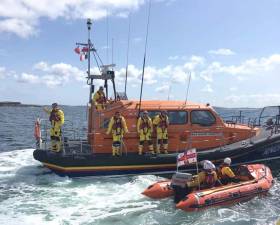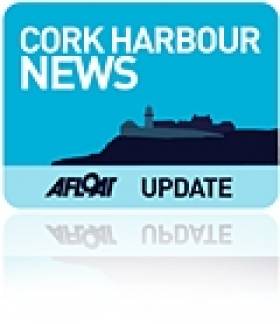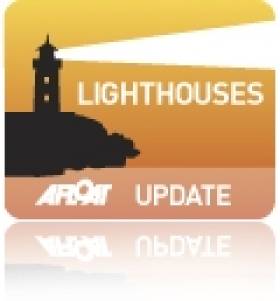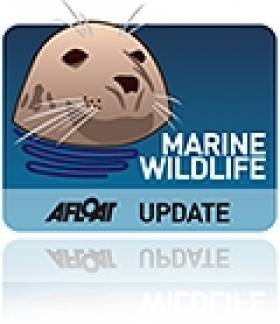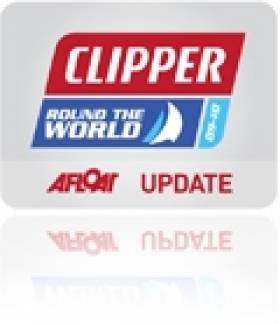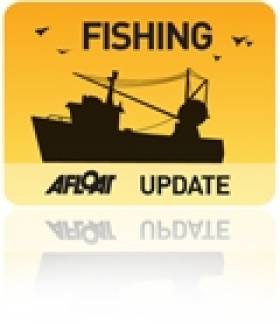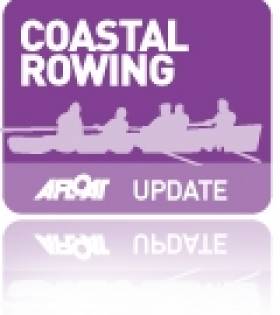Displaying items by tag: Lorna Siggins
‘A Surreal Dance Across the Swell’: An Air Corps Dauphin’s First Night Rescue Off Donegal
In the third instalment of our three-part series of extracts from Lorna Siggins’ new book, Search and Rescue, the journalist and regular Afloat.ie contributor hears from Commandant Jurgen Whyte about his and his crew’s extraordinary efforts to aid the stricken fishing vessel Locative off Arranmore 32 years ago…
Joan O’Doherty (McGinley) had led a very successful campaign from 1988 to establish the Irish Marine Emergency Service (later the Irish Coast Guard) after fisherman John Oglesby lost his life within sight of the Mayo coast.
The government’s decision to concede Shannon as a west coast air-sea rescue helicopter base was to prove its worth just a month after the report was issued, when the Air Corps search and rescue crew, relocated to the west, were involved in a most dramatic mission. “I have never seen such a sea state in my [fifteen-year] flying career,” Commandant Jim Corby noted afterwards.
The distress call came shortly after midnight on the night of 8/9 March 1990. A 20-metre fishing vessel, Locative, with four crew on board, had lost engine power and was taking in water somewhere off Arranmore Island in Donegal.
Commandant Jurgen Whyte, Dauphin commander on duty, alerted the crew — co-pilot Commandant Corby, winch operator Sergeant Ben Heron and winchman Corporal (subsequently Flight Sergeant) Daithí Ó Cearbhalláin.
Whyte was one of the search and rescue unit’s most experienced pilots, having flown initially in fighter squadron jets. He had held several key posts, including officer commanding the Naval Service support squadron, and officer commanding search and rescue.
Earlier that evening the crew had abandoned a winching exercise due to bad weather. A north-westerly gale was gusting to severe gale force 9, with seas of 3 metres and a very heavy swell of up to 10 metres in height. Whyte was concerned about the wind conditions and the lack of information on the vessel’s position. He requested support from an RAF Nimrod and a Sea King helicopter from Britain; the Arranmore lifeboat was also en route.
Corby got a detailed weather briefing. The worst conditions would be in and around Arranmore Island, with winds of over seventy knots and a heavy rolling sea. The captain decided to fly to Finner, refuel and reassess the situation there.
The Dauphin took off from Shannon for Finner at 1.55 a.m., and by Castlebar it had made contact with the RAF Nimrod. Flares had been sighted by another fishing vessel south of the island of Arranmore and close to Rathlin O’Birne. However, the helicopter crew was under pressure as the MRCC had informed them that the RAF Sea King had had to turn back due to icing weather conditions.
It had taken an hour and fifteen minutes to get to Arranmore, but the work was only beginning
The Dauphin made visual contact with the Nimrod when it reached Sligo Bay at about 3.10 a.m. Nothing had been heard from the fishing vessel for thirty minutes. By chance the Dauphin heard the Locative on VHF channel 24. Using direction-finding equipment, the Air Corps crew estimated its position to the west.
Several minutes later both the helicopter and the Nimrod spotted a red flare. There was no time to refuel; in any case they had enough fuel for ninety minutes. The helicopter flew out to the vessel, which was drifting broadside in an enormous Atlantic swell. The four crewmen were huddled at the stern of the heaving vessel, fortunately visible under a full moon. All were wearing lifejackets, a rare enough occurrence in such emergencies at the time.
It had taken an hour and fifteen minutes to get there, but the work was only beginning. The aircrew spent another thirty minutes trying to hold the aircraft over the vessel to allow winchman Ó Cearbhalláin down safely. As he recorded afterwards, the pitch and roll of the vessel was the worst he had seen to date during his career. He had to take account of the gear on deck, including a large ship’s aerial, a derrick at the bow and several lines and aerials running between it and the wheelhouse.
“The vessel was rising and falling 80 feet [24 metres] in the swell,” Whyte said. “This successive rate of change exceeded the capability of the Dauphin’s automatic hover system.” The hover system allows the pilot to set the minimum height between the belly of the aircraft and the sea; the aircraft will rise and fall with the swell ‒ and automatically fly away if that sequence is broken.
Whyte opted to fly the helicopter with manual height control, which involved the continuous calling of heights by the co-pilot, while the winch operator monitored how close they were to the sea’s surface. As Ben Heron explained, “You can see the clearances. It is the pilot’s job to do what he or she is told, and it is all based on trust.”
There was an additional danger: the aircraft was at constant risk of being skewered by the mast of the vessel below. “Due to the wind position of the Locative, I couldn’t see it below me and under these conditions the chance of collision is very high,” Whyte said. He decided to stand off and wait for the arrival of the Arranmore lifeboat.
Within fifteen minutes the lifeboat arrived — to the relief of the Dauphin crew. It was now 3.35 a.m. Over the radio the aircrew explained that they couldn’t attempt a lift with the vessel lying parallel to the swell and at “cross decks” to the helicopter in hover.
The lifeboat made several unsuccessful attempts to approach the Locative. At one stage Whyte recorded, “We witnessed the trawler bearing down on top of the incoming lifeboat” — and only “prompt, evasive action” by the coxswain averted a collision.
“We thought the lifeboat would be able to come alongside and drag the guys off the deck. Instead, we witnessed this incredible sight where the lifeboat was trying to dart into the vessel and the Locative would rise up over the swell and fall down towards it. The coxswain was incredible, but we knew then that the lifeboat wasn’t going to do it.”
‘The two vessels — lifeboat and Locative — were engaged in a surreal dance across the swell’
There was just forty minutes of hovering time left. The fishermen were totally dependent on the helicopter; if it flew away to refuel, the four men might not survive. The pilot and winch operator remembered reading an account of a rescue where a lifeboat had pulled a powerless vessel around.
“Picture the situation where the helicopter was hovering north‒south, and the vessel was lying east‒west. If the vessel could be pulled into a north-east position, we could at least see part of it,” Whyte explained.
The aircrew suggested that the lifeboat try to secure a line aboard and pull the vessel to a thirty-degree heading off wind, which might be enough to provide visual clues for the helicopter in hover. Coxswain John O’Donnell managed to get two tow lines on board and manoeuvred the Locative successfully into position.
“Once the vessel was lying at this 30-degrees offset, I could see a pattern,” Whyte said. “The two vessels — lifeboat and Locative — were engaged in a surreal dance across the swell, to the extent that the captain could anticipate the movement of one by the other. That sequence developed a distinct pattern, and this allowed us to go in safely.”
At this point the winch crew lowered the hi-line, a light line with a weight on its lower end, attached by a weak link to the helicopter’s winch cable. This allows the crew of a vessel to guide the main winch wire while the winchman, a stretcher, or a lifting strop is lowered and lifted away again, but it must never be attached to anything fixed. The winch crew hoped that the fishermen would know what to do with it and wouldn’t secure it to anything on the deck.
Ó Cearbhalláin descended and within a few minutes he had sent one of the crewmen up. “Due to the big swell the finer points of winching … were discarded and the survivor was ‘snatched’ off,” Ben Heron said afterwards in his report on the mission.
Once Heron had hauled the first survivor into the helicopter, he winched the strop back down to Ó Cearbhalláin. The hook got caught in a fishing net, but the winchman freed it and placed the second crewman in the strop.
However, “at this point things started to go wrong”, Heron said. A large wave hit the boat, throwing it up towards the helicopter and snapping one of the two tow lines from the lifeboat. The pilot had to climb rapidly and move back to avoid being hit by the ship’s aerial. Heron winched out as much slack as he could to prevent the second crewman from being dragged off the deck when the boat went over the top of the wave.
With one tow line gone, the coxswain on the lifeboat had to reduce his towing speed to maintain the second line. If it snapped, the vessel was gone. However, in reducing the tow the lifeboat and helicopter had to cope with the more erratic and haphazard motion of the vessel, which made winching all the more difficult.
‘The strain on all concerned was particularly severe … The crew didn’t know for how much longer the hoist would hold out’
As if there wasn’t enough going on, Ó Cearbhalláin noticed a problem with the hi-line, which was no longer attached to the helicopter’s hoist hook as it should be — a very rare occurrence.
With great presence of mind, he stuffed a bundle of the hi-line into the strop with the second crewman, just as the boat slid down the back of a wave and the crewman was dragged off and scooped up in a massive swing with the hi-line tangled around him. Heron recalled that he only knew he had the man when he felt the shock coming back up through the cable. “He spun around and got all caught up.”
The winch operator untangled the hi-line furiously as he had no knife to cut it. He then had to replace the “weak link” with one from a spare hi-line and winch the strop back down to Ó Cearbhalláin. It took a good ten minutes to make the repair. Fuel was running low and the winchman was getting anxious. The delay seemed like an eternity, according to Corby. His colleague, Whyte, had to maintain a hover which was “too close for comfort” over the vessel, without the vital assistance of “patter” from the winch operator.
“The strain on all concerned was particularly severe, as we had been in the manual hover for over an hour in the worst conditions any of us had ever seen. The crew didn’t know for how much longer the hoist would hold out in the violent snatch lifts,” Corby said.
With just twenty-five minutes of fuel left, winching resumed, with the third “snatch lift” as hazardous as the previous two. Shortly after the last fisherman was taken off, and as the lifeboat was towing the Locative, the second tow line snapped and the vessel was left to the mercy of the sea.
The helicopter routed directly to Finner with the four fishermen and landed with just five minutes of fuel remaining. Coxswain O’Donnell later told the Air Corps board of inquiry that it was a “hellish night”; a fitting statement, the Air Corps noted, from a man who had received a citation for his courage from the RNLI.
The aircrew agreed that the lifeboat was crucial in helping to position the fishing vessel and in acting as a visual reference. Both crews had demonstrated great courage, stamina and seamanship. The pilots knew that the winching crew were the very best they could have hoped for — “top guns”, Whyte remarked afterwards.
The vital need for constant radio communication between winchman and aircraft was raised by members of the aircrew in their reports to the Air Corps. For their efforts they were awarded a DSM with distinction, the first time a Dauphin crew had been recommended for one. It was also the first such medal for a sea rescue, and the first night rescue by a Dauphin attached to the Air Corps fleet.
From Chapter 10, A Developing Service. Search and Rescue: True Stories of Irish Air-Sea Rescues and the Loss of R116 by Lorna Siggins is published by Merrion Press, €16.95/£14.99 PBK.
‘I Knew I Could Not Sail Back, So I Had to Make a Decision’: Kerry Windsurfer Tells of His Fight for Survival
In the second of three extracts from Lorna Siggins’ new book, Search and Rescue, the journalist and regular Afloat.ie contributor revisits the fateful day in November 2018 when a sudden wind drop left windsurfer Lorenzo Cubeddu cast adrift off Ballybunion in fading daylight…
When Italian-born Lorenzo Cubeddu set out for a short windsurfing spin off his local beach in north Kerry one November afternoon, he met an angler he knew on the strand and they had a chat about the weather. Further up the beach, Lorenzo’s wife, Amanda, was struck by the image of two experienced men of the sea chatting near the Atlantic shoreline and took a photograph. Some time later, she remarked that this could have been the last photo she had of him alive.
Lorenzo had moved to Ireland from Sardinia in 1998, drawn by his love of sailing, windsurfing and diving. He trained as an RNLI lifeguard, windsurfing and dinghy instructor, and participated in ocean-going sailing. After he met Amanda, they settled in Inch East in Kerry, and he took a job at the SuperValu in Ballybunion.
On that particular day, 11 November 2018, he had spent an hour checking the sea state before heading out from Ballybunion beach around 3 p.m. The wind was steady and constant, with good sunny periods, he remembered. After a while, the wind was on and off, making it difficult to stay upwind – especially with the push of the incoming tide and the chop and swells. The leeway or sideways drifting prevented him from getting back to shore, but he had found himself in these conditions before and was always able to make it back to his point of launching.
“So I kept trying to make ground upwind for a while, only to realise that I had drifted too far from the beach and was facing the cliffs every time I sailed back. I wanted to avoid being crashed onto them by the push of the tide and waves, and to give myself a good, safe distance from the cliffs with time to think about my next move before darkness arrived.”
However, the wind then dropped completely, leaving him stranded in the middle of the bay, lying on his board with daylight fading. “I knew I could not sail back, so I had to make a decision: drop the rig and try to paddle back to land? Or stay with that moment, with the fading light, the large swells and my distance from land, I was too far to be seen by anyone...”
He knew that if he panicked, he would not make it at all. He detached the sail, knowing it could have dragged him in the water like an anchor. “It was a hard decision, but I had no choice, so I lay on my stomach on the board.”
However, the tide was too strong to make headway. Darkness was closing in, and he began to lose his bearings. “We have a saying in Italy: ‘If you want to learn to pray, go to sea.’ And in that moment it made perfect sense to me,” Lorenzo said. “I keep a very simple but strong faith. So I was praying a lot, and I realised later that everyone I knew – and all of Ballybunion and beyond – was praying for me, which was very humbling.”
‘I got the phone call that you never want to get, and no one ever wants to make’
Lorenzo worked to hold a calm mindset, knew he was in survival mode, and felt very peaceful”. “It was not natural but supernatural. It was also very sad as I thought of my wife. I did not feel ready to leave her … I imagined the reaction of the people at my funeral.”
Bioluminescent plankton lights flickered over his board, and he conversed with the tiny organisms as he felt they represented “life and company … a little miracle of light in the darkness”.
The weather was changing, the wind was picking up and there was a 4-metre swell on the Fenit side of the bay. Still lying on his stomach, with his hands up at the bow and trying not to swallow the sea water which was splashing over his head, he had to close his eyes to protect them from the stinging spray and the rain. Breathing methods he had practised at home began to help.
“After what felt like a long time, I started to feel the cold and the first symptoms of hypothermia kicked in. Even with the help of the neoprene wetsuit, boots and beanie hat, I was freezing.” He knew his position on the board was not helping, as half of his body was in the water, and he was seasick a few times. “If you think of being in the same position for so many hours, it was not surprising.”
Then, he heard a noise – a distinctive, comforting roar in the sky ‒ and spotted the searchlight of a Coast Guard helicopter. It flew past and disappeared into the distance. He knew he wasn’t quite in range for the helicopter’s ‘Nightsun’ light or its thermal imaging camera. Though the crew hadn’t seen him, and he knew he was just a tiny speck in a black ocean, he drew great comfort from the knowledge that a search had begun. It gave him “new strength and hope” and pushed him “harder to survive”.
Back on shore, Lorenzo’s wife, Amanda, had rung him a few times, but got no answer. Normally, they would have a lot of phone contact. She had an unsettled feeling. “Then I got the phone call that you never want to get, and no one ever wants to make: confirmation from Lorenzo’s boss Cormac Cahill in SuperValu that Lorenzo was missing at sea, and a search was underway,” Amanda said.
Amanda fell to the floor in a terrified physical state. Her friends called to the house and picked her up to drive her to the sea to look for her husband. She recalled it was “excruciating, as all in the car knew they were facing hours of horror”.
As the time passed, Lorenzo found himself saying, ‘Okay, if this is it, please God don’t make it last too long…’
The first thing she remembered noticing was how dark it was as she stared out into what seemed like an abyss. She was reassured by the lights of the rescue service trucks and the Garda car and knew they would do everything they could to find him. She could hear the Coast Guard helicopter and its large searchlights gave her hope. She remembered how her shock turned to gratitude, as she saw how the cliff was lined with people from Ballybunion.
“There were many others also, and I couldn’t believe they were there for us ‒ people kneeled to pray, words of firm encouragement, and I felt very humbled,” she said.
Cormac, Lorenzo’s boss, offered Angela the sort of support she will never forget, both then and in the days after. “When my energy was flagging, Cormac kept showing me Lorenzo’s details on WhatsApp ‒ it said, “never give up never surrender”. All our friends stood shoulder to shoulder with me, some just far enough away to give me space but close enough so I could read their eyes.”
She said An Garda Síochána also kept a very close eye on her, ensuring she sat in the front of the squad car. She joked with them that this was her first time in custody. Several times, she tried to get out of the car near the edge of the cliffs to call his name, believing he might possibly hear her. One friend said very firmly, “It will be alright, I’m sure that fella has ended up in Clare!”
Waves of panic alternated with waves of hope, every minute seemed like an hour, and Amanda remembered a sense of being in an unbearable nightmare. At the same time, people who had never met him were now abseiling down cliffs, searching beaches and fields, praying in the local church, and supplying sandwiches and coffee, and she felt sure that Lorenzo could “feel this outpouring of love on the water”.
At 9.30 p.m., with no word still, Amanda said she decided to “send him a prayer to rest in peace, in case he needed that from me”. A group of her friends prayed with her for his body to be found. Her thoughts turned to telling his elderly mother, his family in Italy and her own family in Dublin.
‘I felt as though I should have died several times already. So all I could do was to stay calm and strong for as long as I could’
As the time passed at sea, Lorenzo fought off exhaustion and found himself saying, “Okay, if this is it, please God don’t make it last too long … make me go to sleep.” But he heard a voice in his head urging him to stay awake. His knew his only chance of survival now was to be “pushed back to land by the current, chop and swells, hopefully without getting injured or being crashed onto the cliffs”, or to make it through the night at sea.
“I felt as though I should have died several times already. So all I could do was to stay calm and strong for as long as I could.”
He suddenly heard a swishing, crashing noise that made him think he was near land or cliffs, and to his delight he was right.
Being so near the coast, though, he knew he was in danger of being dashed on rocks. He had to gamble on letting go of the board to try to find his footing.
‘I threw the board away with all the force I could, as it could be “game over’ if the board hit me on the head. I took one leap and landed on a ledge! Then I was faced with climbing a jagged cliff, arms nearly giving way with exhaustion. I struggled for hand holds to haul myself up. Miraculously, grass at the top held my body weight.”
Fortunately, he had some small protection as he was also wearing his neoprene booties for the first time in months ‒ windsurfing is normally better in bare feet. Standing at the top of the cliff in the darkness, he had no idea where he was and there was no sign of life or lights. He was more aware of the cold now and his body was cramping up.
“The first thing I had wanted to do when I landed on the ledge was to find a place to curl up and sleep, but the voice in the back of my head kept saying: “Stay awake!”” He began to wonder if he had been better off in the ocean, as he started to trudge “robotically between hedges, ditches, climbing over gates and fences. I even received a few shocks from electric fences!” He remembered laughing out loud and exclaiming, “Really?!”
After a while his eyes adjusted to the dark, and he noticed a little light to his right. It came from a mobile home. A man with blue eyes and a big beard answered his knock, and his first words were a plea – “Don’t rob me.”
The man’s terrified gaze then turned to one of puzzlement; he had heard a report on Clare FM radio of a missing man at sea and realised who Lorenzo was. He brought him in, put a coat around him and phoned for help, telling Lorenzo he had not charged his phone in weeks but had done so just the night before. He gave him a cup of tea from his gas fire, telling the windsurfer that he had been a fisherman for many years…
From Chapter 14, South-west Sea Sense. Search and Rescue: True Stories of Irish Air-Sea Rescues and the Loss of R116 by Lorna Siggins is published by Merrion Press, €16.95/£14.99 PBK.
‘It Was Horrible to Be Out There’: Galway Cousins Share the Story of Their Harrowing Paddle Board Ordeal
In the first of three extracts from Lorna Siggins’ new book, Search and Rescue, the journalist and regular Afloat.ie contributor recounts the harrowing ordeal of two Galway cousins, Sara Feeney and Ellen Glynn, who were reported missing on 12 August 2020 after they went paddle boarding off Furbo beach in Co Galway…
Air temperatures of around 18 degrees had fallen to 15 degrees during the night. Even though the sea was warm – at around 18 degrees – the estimates for survival at sea in normal clothing would be around twenty hours. The two women weren’t aware of this, but they were well aware of their vulnerability in bikinis and lifejackets.
Ellen was worried about her own lack of tolerance for cold, but the water had been warm that evening. They kept checking the shore lights, paddling and waiting, and still feeling bad about ‘all the hassle we were causing’.
Neither wanted to say what they really thought. Ellen, who was a little stressed, felt an uncontrollable urge to burst into song. She belted out the lyrics of Taylor Swift’s ‘Exile’. ‘At first I’d say Sara thought I was a bit insane,’ she said later. ‘But she just sorta started singing along … it was a distraction … that was just before the first boat came.’
Sara recalled: ‘We definitely knew there was activity and people looking for us. At one point, a boat lit a flare close to us to signal to the helicopter … We thought they would pick up the reflective strips on the boards, or on our buoyancy aids. … Not long after that, we saw the first helicopter. It felt like they were very close … You get that initial sense of relief and then … we would scream and roar and no one could hear.’
They continued to paddle, all the while straining to identify the lights on the shore. In the downdraught caused by the helicopters and the wash from searching vessels, they struggled at times to stay on the boards. Ellen had fallen off once already, earlier in the night. Instinctively sensing they needed to keep their spirits up, they chatted about what they would most like to do when they arrived back. Ellen said she was really looking forward to a hot shower and getting into comfy pyjamas. They talked about how lucky they were to have their lifejackets on, how people were looking for them, how they were going to be found and how everything would be fine.
 Father and son Patrick and Morgan Oliver, who rescued Ellen Glynn and Sara Feeney after they were found off Inis Oírr in August 2020. With the Olivers are Galway RNLI lifeboat crew members (from left to right) Olivia Byrne, Sean King, Ian O’Gorman, Cathal Byrne, Stefanie Carr, Declan Killilea and Lisa McDonagh who were out all night on the search | Credit: Joe O’Shaughnessy
Father and son Patrick and Morgan Oliver, who rescued Ellen Glynn and Sara Feeney after they were found off Inis Oírr in August 2020. With the Olivers are Galway RNLI lifeboat crew members (from left to right) Olivia Byrne, Sean King, Ian O’Gorman, Cathal Byrne, Stefanie Carr, Declan Killilea and Lisa McDonagh who were out all night on the search | Credit: Joe O’Shaughnessy
Ellen remembered at one point thinking about how cold it must be for those sleeping out every night with no homes to go to. She only had to be ‘there for one night’, she told herself. The line from ‘Exile’ about seeing ‘this film before’ and not liking the ending kept looping around in her head, and she sent silent mind messages to her mum, reassuring her that she was okay.
While on the water, they witnessed the meteor shower and marvelled at bioluminescent light for a time as the seas were lit up by the chemical reactions of millions of tiny marine organisms.
‘So I remember, when we saw the shooting stars, I’d always wanted to see them, so I thought that was really cool, and then the plankton in the water,’ Ellen said. ‘They’d been in the water a year before that, and I didn’t get to see them, so I was kind of thinking in my head, “Am I getting to see all this stuff now because I’m going to die?”’
Sara said: ‘With the meteor shower, between the two of us there was some amount of wishes made. To be honest, I’d sacrifice a meteor shower and bioluminescence just to get home safe...We were singing, talking, anything we could to keep our moods up. If fear was seeping in, one of us would reassure the other...
‘It was horrible to be out there and realise everyone would be worried sick, and it felt really awful that everyone spent so many hours looking for us. I think if we had panicked at all, things could have been very different. I know if Ellen had panicked, I would have found it very difficult.’
The weather deteriorated and the rain was so heavy that it hurt. They had stopped seeing any lights of vessels, any search activity now. Their last sight of a helicopter was just before the lightning storm at around 4.20 a.m. When the aircraft flew off, they knew they would have to stick it out to first light.
At that point, Sara had a clear memory of being enveloped in a fear that she could not articulate, knowing the impact any mention of this might have on her cousin: ‘The chances aren’t too good for you if the helicopter couldn’t be out in those conditions … you know … because the size of the helicopter compared to us and all we have is the boards … You see the helicopter going in, because of the stormy weather, and that didn’t bode well for us. We didn’t even verbalise what might happen, or what we might both be thinking. Ellen probably had total understanding of what was going on, but neither of us really communicated that to each other … we didn’t really say that out loud at the time. If we had started talking like that, it was just another level of hopelessness we didn’t need.’
 The Galway RNLI inshore lifeboat returning after the cousins were found on their paddle boards off the Aran island of Inis Oírr | Credit: Joe O’Shaughnessy
The Galway RNLI inshore lifeboat returning after the cousins were found on their paddle boards off the Aran island of Inis Oírr | Credit: Joe O’Shaughnessy
They lay down on the boards, trying to stay as stable as possible in waves of up to 2 metres in height, hoping they could just wait the night out. Ellen thought they were being carried towards Kinvara, though she wasn’t sure.
Sara had a sense her cousin might be falling asleep, so she played word games with her to keep her alert and urged her to kick her legs every so often to keep warm.
***
The Galway RNLI crew came alongside Barna pier during the night for extra fuel and a crew change. By 5 a.m. local fishing vessels were out.
Back on Cappagh road, the light came on in Mary Feeney’s bedroom, waking her and her husband, Tommy. Her eldest, Karen, and youngest, Donal, were at the foot of her bed. They explained that they had some news. Her two granddaughters were missing at sea. As she tried to make sense of the information, Mary remembered giving Karen and Donal a couple of lamps to take back out with them.
Back in Galway lifeboat station, co-ordinator Mike Swan arrived around 6 a.m. to check in with his colleague Barry Heskin, who had been on duty throughout the night. The situation was not looking good, given the night’s bad weather on the bay. Some of the lifeboat crew who had been out in the early hours had crashed in chairs or were lying on the pool table to grab some sleep. Breakfast rolls had sustained them during a long night at sea and Swan had organised a box of the same for colleagues on the RNLI Aran lifeboat.
Sailor and yacht chandler Pierce Purcell received an early morning call and set his energies to putting the word out among the sailing clubs, while the family put out posts on social media, appealing for help. Several fishing vessels contacted John O’Donnell on the Aran lifeboat to get advice on where to search. Ferries serving the Aran Islands based in Doolin and in Ros-a-Mhíl also declared they would assist. Several private pilots – John Kiely and Patrick Curran – joined in with a light plane and helicopter respectively, as did Aer Arann on its routine flights between Indreabhán and the islands.
 An Irish Coast Guard S-92 landing at University Hospital Galway with cousins Ellen Glynn and Sara Feeney on board, after they were flown from Inis Oírr | Credit: Joe O’Shaughnessy
An Irish Coast Guard S-92 landing at University Hospital Galway with cousins Ellen Glynn and Sara Feeney on board, after they were flown from Inis Oírr | Credit: Joe O’Shaughnessy
‘We took one of our ferries out from Doolin at 9 a.m. – the Jack B – with Captain James Fennell, my nephew Martin Garrihy and myself on board. Island Ferries was also searching in between sailings out of Ros-a-Mhíl, and Bill O’Brien of Doolin Ferries,’ Donie Garrihy said.
‘We scoured around Inis Oírr and were then told to search between Inis Oírr and Inis Meáin as far down as the lighthouse, and then got a call to double back up from Inis Oírr towards Spiddal.’
The Oranmore-Maree Coastal Search Unit became involved, as did the Marine Institute. The institute had expertise in modelling, combining tide, currents and weather to predict drift patterns on the bay. Over the first daylight hours, there were a number of reported sightings: several kayakers out searching and several objects that turned out to be lobster pots were mistaken for the paddleboarders.
Galway Bay’s name belies a sea area as large as the county. As Mike Swan explained later: ‘It is like driving from Galway east to Ballinasloe, and then searching from Loughrea in the south-east to Athenry to the north-west … a big area, a load of fields, and then you are looking for two girls and it’s night-time. If there’s a wave at all and someone is 100 metres away, there’s no way in hell you’re gonna see them … you only see them when you’re on the top of the wave … and you must remember too that the boat they’re in might be on the bottom of the wave. So it is all about searching slowly and methodically …’
Friends, relatives and people who didn’t know the families drove many miles to join the search, some having left their homes in the middle of the night. Deirdre was aware of her daughter’s resilience, and the fact that both young women were, as her sister Helen put it, two smart, sensible girls. She had an inexplicably strong sense of hope and, for some reason, she couldn’t get a Taylor Swift song out of her head.
From Chapter 17, “Why aren’t they turning around?”. Search and Rescue: True Stories of Irish Air-Sea Rescues and the Loss of R116 by Lorna Siggins is published by Merrion Press, €16.95/£14.99 PBK.
RNLI Clifden Welcomes its First Shannon-Class Lifeboat
North Connemara’s Clifden has become the first west coast RNLI station to receive a new Shannon-class lifeboat writes Lorna Siggins.
The all-weather Shannon, which was designed by an Irish engineer and is the first RNLI class to be named after an Irish river, was given a warm welcome by several hundred people at Clifden Quay yesterday.
Named the Brianne Aldington, the 13-metre Shannon reduces response times to call-outs, as it has a top speed of 25-knots. It replaces the Mersey-class 15 knot vessel at Clifden and represents a 2.4 million euro investment by the RNLI in the west coast.
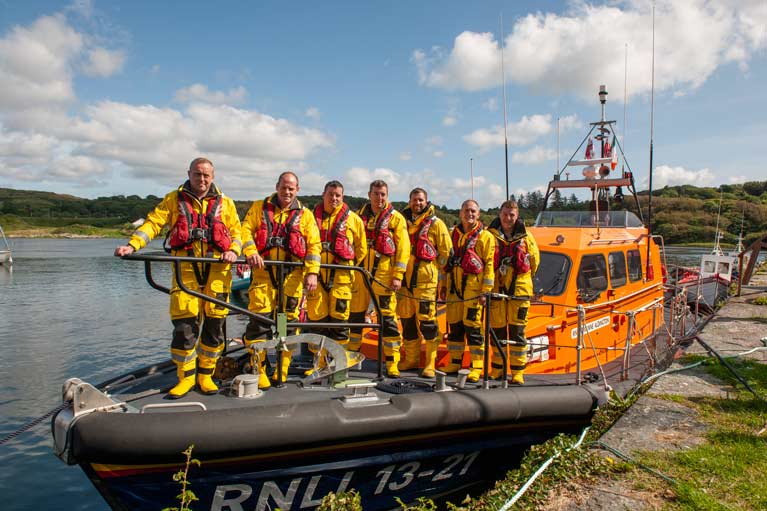
The Shannon was designed by Derry man Peter Eyre who as a child was rescued by Lough Swilly RNLI in Donegal. It has a maximum speed of 25 knots and an endurance of 250 nautical miles.
It is propelled by waterjets, rather than propellers, and it can be driven directly onto a beach for recovery.
The vessel can be recovered directly from the beach by her launch and recovery tractor. Once winched up from the beach, the tractor’s carriage revolves 180 degrees so that the lifeboat is repositioned for relaunching.
The 24-person voluntary crew at Clifden includes a husband and wife and a father and son, while two of its four coxswains are brothers.
Clifden RNLI coxswain James Mullen recalled yesterday how the station received its first all-weather craft three years ago and was thrilled then.
“ However, with the arrival of the Shannon, we have 21st-century lifeboat design and technology. Bringing her home to Clifden from Poole was one of my proudest moments. As we rounded Loop Head we hit a bit of weather and we really made her dance,” he said.
“ The ergonomic seats bear the force of the impact of the lifeboat hitting the waves, and the improved communications technology means the crew can talk to each other by linked headsets and can hear each other above the noise and receive information directly from the Coast Guard,” Mr Mullen said.
The Clifden crew have trained intensively since May and will consolidate this off the Connemara coast before the Shannon is declared on service and the Mersey is retired. The former lifeboat will be sold on to a charity.
The RNLI says the first planned outing for the new lifeboat is to visit the nearby island communities on Inishbofin and Inishturk.
The new vessel left RNLI headquarters in Poole for Clifden on July 24th for its delivery run across the Irish Sea, crewed by two coxswains, David Barry and Alan Pryce, two mechanics, Thomas Davis and Andrew Bell and navigator Owen Hayes.
There are currently two Shannon-class lifeboats at Lough Swilly in Donegal and Clogherhead, Co Louth, and a relief vessel at the Wicklow station.
Clogherhead received its Shannon-class in early June. The vessel was funded through a generous legacy by a Wexford farmer, Mr Henry Tomkins, who was a lifelong supporter of the RNLI. Mr Tomkins stipulated that a lifeboat be named after former Arklow RNLI coxswain Michael O’Brien, his lifelong friend.
#haulbowline – Marine minister Simon Coveney says there has been no final decision taken on an 'Ocean Yacht Racing Hub' within the Naval Service base at Haulbowline island in Cork Harbour.
In this morning's Irish Times newspaper, marine correspondent Lorna Siggins writes that a British yacht racing consultancy has met Government agencies as part of a 'grand plan' for haulbowline island, site of a former steelworks site. The plan for the yacht base was first mooted by British solo racer Alex Thomson when he called into to Cork Harbour for repairs last April before heading across the Atlantic Ocean.
As Afloat.ie reported last October, Thomson, together with his shore manager Stuart Hosford, a Cork native, returned to the harbour and gave a public lecture about his solo sailing success that also included comment about the potential to develop the harbour site. The visit was part of an 'Innovation Week' in Cork where Cork Institute of Technology, the Irish Naval Service and University College Cork promoted the first Imerc Innovation Week.
Interest in the Haulbowline site focuses on the substantial graving dock where large yachts measuring up to over 100–foot in length or more could be lifted in an out of the water in a deep water environment with convenient access to the Atlantic.
Haulbowline has been making headlines for years because of cancer-causing residue, left over from the Irish Steel plant that once occupied the land. It has been confirmed that a cache of 500,000 tonnes of slag and toxic waste material were buried at the former steelworks. Afloat reported on the hot site in the harbour in 2011.
More in the Irish Times on the Yacht Hub story here.
Foghorns Fall Silent
Ireland is Home to a Basking Shark Population
Irish Clipper Entry Named both 'Derry' and 'Londonderry'
Next year's Irish entry in the Clipper Round the World Race may be named twice according to Lorna Siggins in the Irish Times. The local yacht could bear the name Derry on one side of its bow and Londonderry on the other, as it circumnavigates the globe – to appease all political interests on the river Foyle. More from the Irish Times HERE.
New Safety Regs Anger Fishermen
Galway's Atlantic Oarsman in World Record
At the beginning of August, a 23ft four-man rowing boat arrived off The Lizard, England's most southerly headland and the traditional point for Transatlantic bids, to establish a new transoceanic rowing time for the crew of one Irishman, two Scotsmen, and a Faroes islander. Lorna Siggins of The Irish Times set the scene as they made their first landfall approaching the Isles of Scilly fifty miles westward. Click HERE.
Click this link for Irish Rowing detailsClick this link for the Latest Rowing News


























